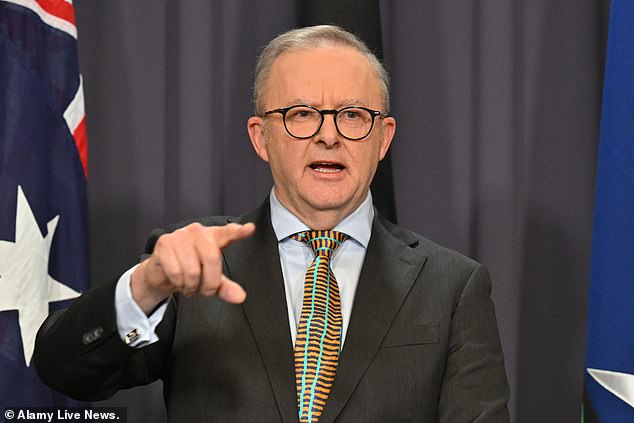Australia is accepting more than 10,000 migrants a week despite Anthony Albanese promising to halve the number of new arrivals by next year.
More than 1,500 people arrive every day, or 60 migrants every hour, according to new data from the Australian Bureau of Statistics.
Australia will welcome more than 500,000 migrants in 2024 alone as people struggle with a worsening housing and cost of living crisis.
An additional 4,200 homes are needed each week to maintain the current level of growth; however, fewer than 1,000 are currently being built.
The sobering immigration figures come just weeks after the Prime Minister promised his government would halve immigration levels within a year.
Australia is accepting more than 10,000 migrants a week despite Anthony Albanese promising to halve the number of new arrivals by next year.

More than 1,500 new arrivals arrive every day or 60 migrants every hour, according to new data from the Australian Bureau of Statistics (pictured, travelers in Sydney)
Sustainable Population Australia president Peter Strachan called for immigration to be reduced immediately.
“We understand calls to end immigration in light of the terrible effect the addition of a million immigrants in two years had on the housing market, as well as infrastructure and services,” he said.
‘For the past 20 years, immigration has been too high, based on the false claim that we lack enough skilled workers. The resulting population growth has created more skills shortages than it has been able to fill.
‘The real reasons for mass immigration are to keep wages low and increase house prices. This is not in the interests of Australians or immigrants who are among the disadvantaged in terms of both employment and housing.’
Strachan urged that net overseas migration be limited to just 70,000 a year.
Australia is expected to be home to 45 million people by 2070, following an effort to increase the population by 75 per cent in just a few generations.
“We can keep refugee intake at 20,000 and still have room for the skilled migrants that employers want to sponsor, along with their families,” said Mr Strachan.
‘However, Australia should stop importing people on points-test visas, who tend not to get skilled jobs.
‘The only reason the government is doing this is to boost immigration above the numbers employers want. This increases consumption and GDP, but productivity and GDP per capita decrease.’
With an election due within 12 months, the Treasury now expects the 2023/24 migrant intake to fall to 395,000.
‘We are determined to do it. We inherited a system that was a disaster,” Albanese told 3AW in April.

A new Labor Party plan will force universities to build more accommodation for international students amid a huge influx of students (pictured, the University of Sydney)
“And what we’ve been doing is making sure that in areas like vocational education, for example, some people came here doing courses that were, frankly, Mickey Mouse courses, using them to stay here for a very long period of time.
‘What we are doing is returning integrity and rigor to the system. Now, having students come here is an important source of economic income.’
Albanese did not reveal what he thought the annual immigration figure should be.
“We are not just going to pull a number out of the sky, but what we are projecting is that net overseas migration will reduce to 250,000 in the next fiscal year 2024-25,” he said.
Meanwhile, a new Labor plan will force universities to build more accommodation for international students amid a huge influx of students.
Bursar Dr Jim Chalmers announced in May that universities would need to build more housing for international students if they wanted to continue to rely on their initial fees for a lucrative income stream.
By the end of 2024/25, foreign entry was expected to halve, to just 260,000, down from 528,000 in 2022/23.
But in the five years to 2027/28, 1.38 million net migrants are still expected to move to Australia.
With a shortage of construction workers, forcing universities to build more accommodation is expected to make it harder for the higher education sector to accept so many enrolments.
International students make up the majority of long-term arrivals in immigration figures, capped at 190,000 permanent people.
“If universities want to accept more international students, they need to build more student accommodation,” Dr Chalmers said.

An additional 4,200 homes are needed each week to maintain the current level of growth; however, fewer than 1,000 are currently being built (file image)
“We will limit the number of international students each university can enroll based on a formula, including the number of homes they build.”
Almost half of Australians believe there are too many migrants migrating to Australia, according to a survey conducted by the Lowy Institute earlier this month.
The survey revealed that 48 per cent of respondents said the total number of migrants arriving in Australia each year was too high.
This result represented a slight increase from the last time the question was asked in 2019, and remains six percentage points below its 2018 peak.
The number of people who believed the arrival of immigrants was “about right” also dropped from 47 percent in 2014 to 40 percent in 2024.
Despite this, nine in 10 Australians still believe the country’s culturally diverse population has been positive for Australia.


